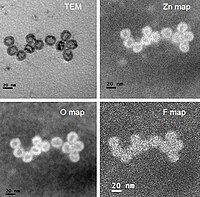
Photo from wikipedia
The authors have synthesised a core-shell Fe3 O4 @TiO2 nanocomposite consisting of Fe3 O4 as a magnetic core, and TiO2 as its external shell. The TiO2 shell is primarily intended… Click to show full abstract
The authors have synthesised a core-shell Fe3 O4 @TiO2 nanocomposite consisting of Fe3 O4 as a magnetic core, and TiO2 as its external shell. The TiO2 shell is primarily intended for use as a biocompatible and antimicrobial carrier for drug delivery and possible other applications such as wastewater remediation purposes because of its known antibacterial and photocatalytic properties. The magnetic core enables quick and easy concentration and separation of nanoparticles. The magnetite nanoparticles were synthesized by a hydrothermal route using ferric chloride as a single-source precursor. The magnetite nanoparticles were then coated with titanium dioxide using titanium butoxide as a precursor. The core-shell Fe3 O4 @TiO2 nanostructure particles were characterized by XRD, UV spectroscopy, and FT-IR, TEM, and VSM techniques. The saturation magnetization of Fe3 O4 nanoparticles was significantly reduced from 74.2 to 13.7 emu/g after the TiO2 coating. The antibacterial studies of magnetic nanoparticles and the titania-coated magnetic nanocomposite were carried out against gram+ve, and gram-ve bacteria (Staphylococcus aureus, Pseudomonas aeruginosa, Shigella flexneri, Escherichia coli, and Salmonella typhi) using well diffusion technique. The inhibition zone for E. coli (17 mm after 24 h) was higher than the other bacterial strains; nevertheless, both the uncoated and TiO2 -coated magnetite nanocomposites showed admirable antibacterial activity against each of the above bacterial strains.
Journal Title: IET nanobiotechnology
Year Published: 2021
Link to full text (if available)
Share on Social Media: Sign Up to like & get
recommendations!